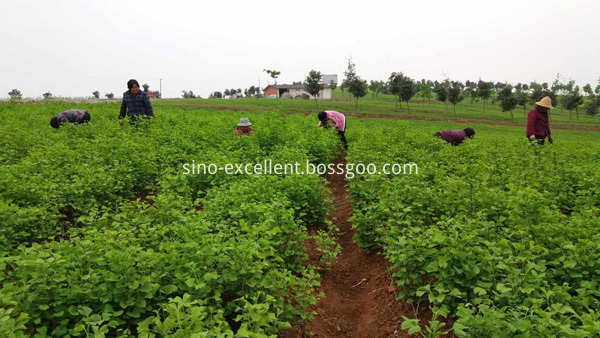Berberine,
Rutin,
Ginseng leaf & stem p.e. ,
Ginseng root p.e.
Ginseng flower p.e.
Green Tea P.e.,
5-HTP,
grape seed extract,
blackcurrant extract,
Monkfruit extract
stevia extract
Ginger root extract
Curcumin
Low pesticide residue
low solvent residue
low heavy metal
non-irradiation
non-GMO
Ginseng leaf p.e. ,Green Tea P.e., herbal extract, plant extract Excellent Health Products Co.,Ltd. , http://www.sino-excellent.com
China is the hometown of Hibiscus. In addition to the cold regions such as the northeast and northwest, other regions have their distribution, especially in Hunan and Sichuan. People often plant them on the banks of the lake and on the waterfront to form a garden landscape with "Hibiscus shining on water." In addition to being used for ornamental purposes, the flowers and leaves of Hibiscus syriacus can be used as medicines, which have heat, detoxification, swelling, and other effects.
Hibiscus can be divided into wild species and horticultural species. There are single and double petals in flower shape. Most of the wild species are single-segmented, and most of the cultivars are double. Hibiscus hibiscus is generally open and thankful. It blooms in the early morning when it is white, it is pink at noon, it gradually turns red in the afternoon, and it fades when it reaches deep red. People describe it as “Xiaozhuang is such as Yu Xia Xiaâ€. The "Drunk Wood Hibiscus." The Hibiscus flower is dark red when it is first opened, white, yellow, pink, purple and so on. It can even open for several days and change color on a daily basis. Even a flower can appear in different colors. Since each flower has its own opening time, it is often accompanied by white, yellow, pink and other flowers of different colors on a wooden hibiscus.
Hibiscus is a deep-rooted plant with a slightly thick root and a warm, moist and sunny environment. It is also tolerant to drought and slightly tolerant to yin. Its extensive nature, strict requirements on soil quality, growth in the loose, breathable, well-drained sandy loam soil. Its cultivation should choose well ventilated, fertile soil, especially in the adjacent water cultivation is better.
The daily management of Hibiscus muscari is rather extensive. Water should be taken care of during drought, and more water should be applied during the spring sprouting period. Before and after the flowering period, a small amount of phosphorus and potassium fertilizers should be applied. Every year in the winter or spring, ditch the plants and apply some organic fertilizer to make them grow vigorously and flourish. When the flower buds pass through the color, the water should be deducted properly to control the growth of the leaves so that the nutrients can be concentrated on the flowers.
Hibiscus grows strong, has strong sprouting power, and has many branches and chaos. It should be trimmed and wiped in time. Hibiscus is resistant to pruning, and it can be trimmed into arborous or pruned shrubs as required. Pruning should be carried out after flowering and before sprouting in the spring. Cut dead branches, weak branches, and inner litchi to ensure good ventilation and light transmission inside the crown. Plants planted in cold regions will have frozen shoots frozen in the winter, but they will sprout more new shoots in the spring of the following year. Therefore, it is best to cultivate its plant shape into shrubs.
Hibiscus potted plants should use larger porcelain pots or plain pots, pots and soils require loose fertility, drainage permeability is good, there must be sufficient water during the growing season. In winter, move to a temperature of 0°C to 5°C in winter to ensure that it is dormant enough to facilitate flowering in the coming year.
The propagation of Hibiscus can be carried out using cuttings, ramets or seeding. Cut-outs are best from February to March. Wet sand loam or clean sand is selected for cuttings from 1 to 2 years of robust branches with a length of 10 to 15 cm. Insert the bottom of the cuttings in a potassium permanganate solution with a concentration of 3 to 4 g/L for 15 to 30 minutes before insertion. The depth of cuttings is preferably 2/3 of the ear length. After the watering, it is covered with film to keep warm and keep the soil moist. After about 1 month, it can take root and it can bloom in the coming year.
It is advisable to carry out propagation of the tributaries in advance of germination in early spring. Digging the mother plants with strong tillers can be divided and planted separately.
Seeding and propagation can be harvested after the autumn fully mature Mufu seeds, stored in cool and ventilated place till the spring of the next year sowing. The hibiscus seed is small and can be mixed with fine sand and broadcast.
Seed bed soil should be fine, after sowing, soiling, watering and keep the seedbed moist, generally 25 to 30 days after the emergence of seedlings, can be transplanted in spring. The common insect pests of M. furfur are grasshoppers, red spiders, and shield bugs. Especially in hot seasons, drought and poor ventilation are most likely to occur. In addition to the timely prevention and control of spraying, the plants should also be timely watered and the necessary sparse shearing.
1. The shield can be sprayed 1 or 2 times with 80% dichlorvos 500-900 times solution or 50% 1000-times solution.
2. Aphids can be used with 1000 to 1500 times dimethoate or omethoate, or 1000 to 1500 times the 2.5% rattan extract, sprayed once every 7 to 10 days, 2 to 3 times.
3. Red spider can use 20% triclosan 800 times, dicofol emulsion 2,000 times, spray every 7 to 10 days, 2 to 3 times.


Hibiscus cultivation technology
Hibiscus hibiscus, alias refrain from frost flowers, is a close relative of hibiscus and hibiscus. It is a deciduous tree shrub of the genus Malvaceae. Its flower shape resembles peony, Lingshuang blooms, extremely beautiful.